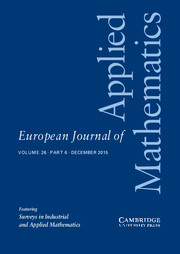Article contents
Transition to blow-up in a reaction–diffusion model with localized spike solutions†
Published online by Cambridge University Press: 07 March 2017
Abstract
For certain singularly perturbed two-component reaction–diffusion systems, the bifurcation diagram of steady-state spike solutions is characterized by a saddle-node behaviour in terms of some parameter in the system. For some such systems, such as the Gray–Scott model, a spike self-replication behaviour is observed as the parameter varies across the saddle-node point. We demonstrate and analyse a qualitatively new type of transition as a parameter is slowly decreased below the saddle node value, which is characterized by a finite-time blow-up of the spike solution. More specifically, we use a blend of asymptotic analysis, linear stability theory, and full numerical computations to analyse a wide variety of dynamical instabilities, and ultimately finite-time blow-up behaviour, for localized spike solutions that occur as a parameter β is slowly ramped in time below various linear stability and existence thresholds associated with steady-state spike solutions. The transition or route to an ultimate finite-time blow-up can include spike nucleation, spike annihilation, or spike amplitude oscillation, depending on the specific parameter regime. Our detailed analysis of the existence and linear stability of multi-spike patterns, through the analysis of an explicitly solvable non-local eigenvalue problem, provides a theoretical guide for predicting which transition will be realized. Finally, we analyse the blow-up profile for a shadow limit of the reaction–diffusion system. For the resulting non-local scalar parabolic problem, we derive an explicit expression for the blow-up rate near the parameter range where blow-up is predicted. This blow-up rate is confirmed with full numerical simulations of the full PDE. Moreover, we analyse the linear stability of this solution that blows up in finite time.
Keywords
Information
- Type
- Papers
- Information
- European Journal of Applied Mathematics , Volume 28 , Special Issue 6: Big Data and Partial Differential Equations , December 2017 , pp. 1015 - 1055
- Copyright
- Copyright © Cambridge University Press 2017
Footnotes
M. J. Ward was supported by an NSERC Discovery Grant 81541 (Canada). J. C. Tzou was supported by a PIMS postdoctoral fellowship.
References
- 5
- Cited by

